'May' Does Not Mean 'Must' in Arbitration Agreement
The lesson is clear; if parties drafting contracts want to be able to compel arbitration involving any New Jersey party, the drafter should take the time to review its existing forms and make them as clear as possible.
May 26, 2019 at 12:00 PM
4 minute read
 arbitration-puzzle-piece
arbitration-puzzle-piece
In the past few months, New Jersey courts have provided guidance to transactional lawyers drafting agreements with arbitration clauses. Employers cannot bury the arbitration provision, as part of a training program, that employees “acknowledge.” Similarly, the section title cannot be misleading, and the font size must meet the standard of the Plain Language Act. Litigation waivers must be clear in consumer cases to meet Atalese standards.
Most recently, the Appellate Division has given the bar a “heads up” when drafting arbitration clauses. In a multi-contract relationship between sophisticated parties, language in the last contract saying the parties “may” arbitrate disputes using specified rules and other parameters was construed to mean that arbitration was permissive rather than mandatory. Medford Township School District v. Schneider Electric Buildings America's, Inc., A-5798-17, — N.J. Super. —, 2019 N.J. Super. LEXIS 54 (N.J. Super. Ct. App. Div. Apr. 26, 2019).
In Medford, the defendant contractor memorialized its winning bid in an energy services construction contract (the ESCC) drafted by the contractor. A prior services agreement between the parties (the PASS) mandated that disputes “shall” be resolved in a court “serving” the local county, and the bid proposal required that the successful bidder “shall agree” to litigate any dispute in Burlington County Superior Court. However, the final ESCC contained an arbitration clause stating, in part, that any dispute arising out of the contract “may be settled by binding arbitration…, and judgment upon the award rendered by the arbitrator(s) may be entered in any court having jurisdiction thereof.” The PASS said that its provisions controlled over conflicting terms in any other agreement, but the later ESCC stated that its provisions governed over any prior oral or written agreements. Both the PASS and the ESCC were on Schneider forms.
When a dispute arose regarding payment and performance, the contractor filed an arbitration with the American Arbitration Association, listing the company's office in Rhode Island. The school district filed suit in New Jersey Superior Court seeking to enjoin and dismiss the arbitration and, instead, litigate the parties' disputes in the Superior Court in Burlington County. The trial court declined to compel arbitration, and the Appellate Division affirmed.
Schneider argued unsuccessfully that the clause was intended to allow either party to elect arbitration, in which case the other was bound to that election. Both courts disagreed with Schneider's argument that construing “may” to be permissive would make the clause “superfluous” since parties always “may” agree to arbitrate. The Appellate Division did not reject these arguments out of hand. As the court said: words such as “either party may demand arbitration” could more clearly have made arbitration mandatory. “Without any conflicting agreements executed between the parties mandating litigation, we might agree with Schneider's position.”
However, not only did the parties use “shall” in other contexts in the ESCC (for example, arbitration “shall be in the county in which the project is located”), but the two earlier contracts contained mandatory venue clauses for any litigation (without mention of arbitration) using the verb “shall.” While one might have excluded evidence of other contracts in light of the integration clause in the ESCC, the court viewed the other uses as helpful in understanding the meaning of “may” rather than disregarding the more recent arbitration clause. The requirement that arbitration clauses “evince a clear intent to waive the right to sue in court,” consistent with Atalese, did not help. Nor did it help that the contracts were drafted by Schneider who, it was said, could have made its intention to mandate arbitration “explicit[]”.
The deficiency identified in Medford may be easily remedied. The lesson is clear; if parties drafting contracts want to be able to compel arbitration involving any New Jersey party, the drafter should take the time to review its existing forms and make them as clear as possible.
This content has been archived. It is available through our partners, LexisNexis® and Bloomberg Law.
To view this content, please continue to their sites.
Not a Lexis Subscriber?
Subscribe Now
Not a Bloomberg Law Subscriber?
Subscribe Now
NOT FOR REPRINT
© 2025 ALM Global, LLC, All Rights Reserved. Request academic re-use from www.copyright.com. All other uses, submit a request to [email protected]. For more information visit Asset & Logo Licensing.
You Might Like
View All

Social Media Policy for Judges Provides Guidance in a Changing World
3 minute read
Bank of America's Cash Sweep Program Attracts New Legal Fire in Class Action
3 minute readTrending Stories
Who Got The Work
J. Brugh Lower of Gibbons has entered an appearance for industrial equipment supplier Devco Corporation in a pending trademark infringement lawsuit. The suit, accusing the defendant of selling knock-off Graco products, was filed Dec. 18 in New Jersey District Court by Rivkin Radler on behalf of Graco Inc. and Graco Minnesota. The case, assigned to U.S. District Judge Zahid N. Quraishi, is 3:24-cv-11294, Graco Inc. et al v. Devco Corporation.
Who Got The Work
Rebecca Maller-Stein and Kent A. Yalowitz of Arnold & Porter Kaye Scholer have entered their appearances for Hanaco Venture Capital and its executives, Lior Prosor and David Frankel, in a pending securities lawsuit. The action, filed on Dec. 24 in New York Southern District Court by Zell, Aron & Co. on behalf of Goldeneye Advisors, accuses the defendants of negligently and fraudulently managing the plaintiff's $1 million investment. The case, assigned to U.S. District Judge Vernon S. Broderick, is 1:24-cv-09918, Goldeneye Advisors, LLC v. Hanaco Venture Capital, Ltd. et al.
Who Got The Work
Attorneys from A&O Shearman has stepped in as defense counsel for Toronto-Dominion Bank and other defendants in a pending securities class action. The suit, filed Dec. 11 in New York Southern District Court by Bleichmar Fonti & Auld, accuses the defendants of concealing the bank's 'pervasive' deficiencies in regards to its compliance with the Bank Secrecy Act and the quality of its anti-money laundering controls. The case, assigned to U.S. District Judge Arun Subramanian, is 1:24-cv-09445, Gonzalez v. The Toronto-Dominion Bank et al.
Who Got The Work
Crown Castle International, a Pennsylvania company providing shared communications infrastructure, has turned to Luke D. Wolf of Gordon Rees Scully Mansukhani to fend off a pending breach-of-contract lawsuit. The court action, filed Nov. 25 in Michigan Eastern District Court by Hooper Hathaway PC on behalf of The Town Residences LLC, accuses Crown Castle of failing to transfer approximately $30,000 in utility payments from T-Mobile in breach of a roof-top lease and assignment agreement. The case, assigned to U.S. District Judge Susan K. Declercq, is 2:24-cv-13131, The Town Residences LLC v. T-Mobile US, Inc. et al.
Who Got The Work
Wilfred P. Coronato and Daniel M. Schwartz of McCarter & English have stepped in as defense counsel to Electrolux Home Products Inc. in a pending product liability lawsuit. The court action, filed Nov. 26 in New York Eastern District Court by Poulos Lopiccolo PC and Nagel Rice LLP on behalf of David Stern, alleges that the defendant's refrigerators’ drawers and shelving repeatedly break and fall apart within months after purchase. The case, assigned to U.S. District Judge Joan M. Azrack, is 2:24-cv-08204, Stern v. Electrolux Home Products, Inc.
Featured Firms
Law Offices of Gary Martin Hays & Associates, P.C.
(470) 294-1674
Law Offices of Mark E. Salomone
(857) 444-6468
Smith & Hassler
(713) 739-1250







